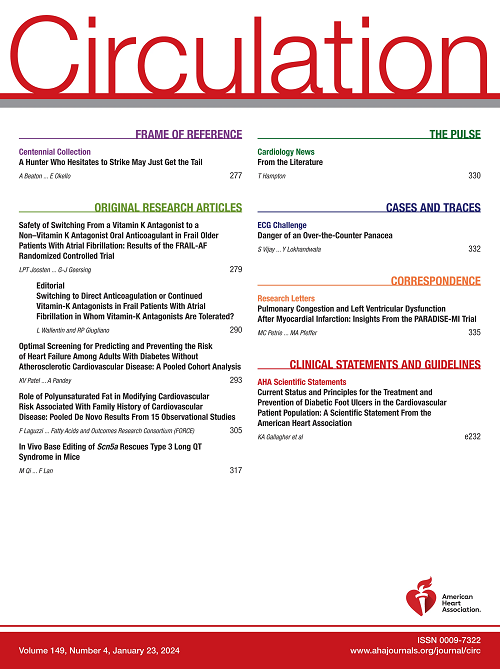重新审视开放静脉假说以减少血栓后综合征:多学科护理和研究的意义:美国心脏协会的科学声明。
IF 35.5
1区 医学
Q1 CARDIAC & CARDIOVASCULAR SYSTEMS
引用次数: 0
摘要
“开放静脉假说”认为,早期血栓清除和静脉血流的恢复可以预防近端深静脉血栓形成后的血栓后综合征。自几十年前提出以来,来自基础和临床研究的新见解促使人们重新评估和完善这一假设。根据这些研究的数据,对血栓后综合征的易感性是由于基因组成、血栓性疾病、对炎症和纤维化的偏好、内源性纤维蛋白溶解能力、症状出现和治疗开始的时间以及抗血栓治疗的疗效的差异而发生的。虽然最初恢复开放的静脉似乎对特定的患者群体是有益的,但在长期静脉通畅、减少血栓复发发作和减少血栓周围(如静脉壁和瓣膜)炎症的情况下,血栓后综合征的缓解更有可能。这些潜在的生物学机制需要进一步阐明,长期目标是通过绘制个体的临床表现及其潜在的危险因素和评估随着临床静脉血栓形成的解决而发生的时间依赖性生物学过程来个性化治疗。这一科学声明(1)强调了开放静脉假说的历史基础,然后展示了对驱动血栓后综合征的病理生理因素的新研究见解;(2)讨论临床应用的深静脉血栓成像方式的优缺点,包括描绘血栓的慢性性和静脉壁损伤状态的潜力;(3)提出以减少血栓形成后综合征为重点发展深静脉血栓形成综合多学科护理的措施;(4)确定需要进一步研究的优先领域和问题。本文章由计算机程序翻译,如有差异,请以英文原文为准。
Revisiting the Open Vein Hypothesis to Reduce the Postthrombotic Syndrome: Implications for Multidisciplinary Care and Research: A Scientific Statement From the American Heart Association.
The "open vein hypothesis" postulates that early thrombus clearance and restoration of venous blood flow may prevent postthrombotic syndrome after proximal deep vein thrombosis. Since its proposal several decades ago, new insights from basic and clinical studies have motivated a re-evaluation and refinement of this hypothesis. According to data from these studies, susceptibility to postthrombotic syndrome occurs as a result of differences in genetic composition, thrombophilic conditions, predilection to inflammation and fibrosis, endogenous fibrinolytic capability, timing of s ymptom presentation and treatment initiation, and efficacy of antithrombotic therapy. Although initial restoration of an open vein appears to be beneficial for selected patient groups, freedom from postthrombotic syndrome is more likely in the setting of long-term venous patency, reduced recurrent thrombotic episodes, and reduced perithrombotic (eg, vein wall and valve) inflammation. These underlying biological mechanisms need further elucidation, with a long-term goal of personalizing treatment by mapping the individuals' clinical presentation with their underlying risk factors and assessing time-dependent biological processes that occur as a clinical venous thrombosis resolves. This scientific statement (1) highlights historical fundamentals of the open vein hypothesis and then showcases new research insights into the pathophysiological factors driving postthrombotic syndrome; (2) discusses advantages and disadvantages of imaging modalities for deep vein thrombosis used in clinical practice, including the potential to depict thrombus chronicity and status of vein wall injury; (3) proposes measures to develop integrated multidisciplinary care for deep vein thrombosis focused on the reduction of postthrombotic syndrome; and (4) identifies priority areas and questions for further research.
求助全文
通过发布文献求助,成功后即可免费获取论文全文。
去求助
来源期刊

Circulation
医学-外周血管病
CiteScore
45.70
自引率
2.10%
发文量
1473
审稿时长
2 months
期刊介绍:
Circulation is a platform that publishes a diverse range of content related to cardiovascular health and disease. This includes original research manuscripts, review articles, and other contributions spanning observational studies, clinical trials, epidemiology, health services, outcomes studies, and advancements in basic and translational research. The journal serves as a vital resource for professionals and researchers in the field of cardiovascular health, providing a comprehensive platform for disseminating knowledge and fostering advancements in the understanding and management of cardiovascular issues.
 求助内容:
求助内容: 应助结果提醒方式:
应助结果提醒方式:


